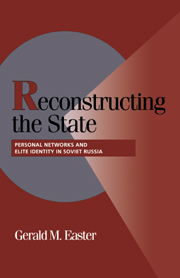Book contents
- Frontmatter
- Contents
- Preface
- 1 Introduction: Explaining State-Building Outcomes and the Soviet Russian Case
- Part I Structure and Identity in the Postrevolutionary State Elite
- Part II Informal Sources of Power in the Postrevolutionary State
- Part III Intrastate Conflict and the Constraints of Power Redefined
- Notes
- Bibliography
- Index
- Titles in the series
Preface
Published online by Cambridge University Press: 13 October 2009
- Frontmatter
- Contents
- Preface
- 1 Introduction: Explaining State-Building Outcomes and the Soviet Russian Case
- Part I Structure and Identity in the Postrevolutionary State Elite
- Part II Informal Sources of Power in the Postrevolutionary State
- Part III Intrastate Conflict and the Constraints of Power Redefined
- Notes
- Bibliography
- Index
- Titles in the series
Summary
The activity of the administrative apparatus poses a greater threat to Bolshevik domination than the actions of officer cadets and Kerenskii. Kerenskii can be arrested and the cadets can be shot with a gun, but the very best gun cannot replace a battered typewriter, nor can the bravest sailor replace a modest clerk in any of the departments. Without the state mechanism, without the apparatus of power, the entire activity of the new government resembles a machine without a driving belt – it goes round and round, but produces nothing.
Tribuna gosudarstvennykh sluzhashchikh, 1917The new Soviet state will be built from the principles of scientific management and from passion and blood.
Valerian V. Kuibyshev, 1924In November 1920, as Baron Petr Vrangel organized the final retreat of White Russia from the Crimean peninsula across the Black Sea, the fledgling Bolshevik regime turned to confront the new challenge of postrevolutionary state building. In three years of civil war, the Bolsheviks mastered the ability to employ coercion against military foes in the field and political opponents at home. Now the Bolsheviks sought to extend their influence beyond the urban industrial areas to Russia's vast rural and multiethnic periphery. But the infrastructural powers of the new state were especially weak at this time. Even Lenin had at first openly speculated that the Bolsheviks would last at best one year. In less than a decade, however, they constructed the foundation and framework of communism's command–administrative state and extended their reach across Soviet Russia's fractious and far-flung regions.
- Type
- Chapter
- Information
- Reconstructing the StatePersonal Networks and Elite Identity in Soviet Russia, pp. xi - xivPublisher: Cambridge University PressPrint publication year: 2000

